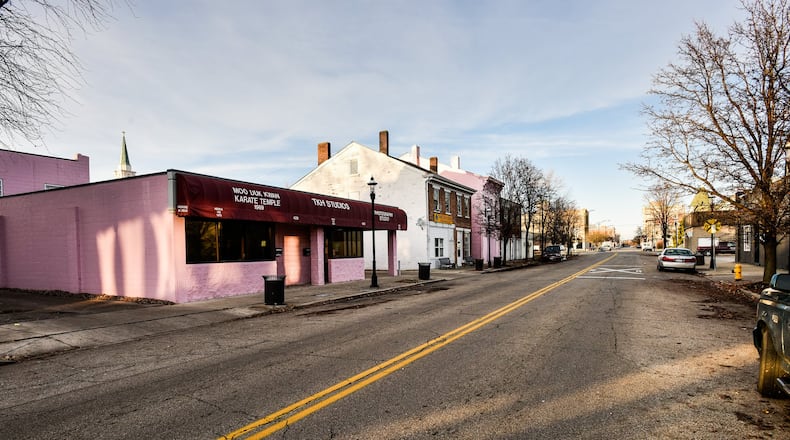The kinds of businesses she’d like to see appear in her neighborhood include “anything with food, and things for kids,” she said. She’d like to see an arcade, and a skating rink.
Those are the kinds of things Mayor Pat Moeller said he’d like to hear from various people in the areas, which are filled with empty businesses and storefronts, many of them with “For Rent” signs in their windows, or “For Sale” advertisements out front.
During a first community meeting on the topic of development in the areas on Dec. 10, Moeller told the audience at the next meeting, each person should “bring a particular block of the Second- or Fourth ward that they’d like to see things start.”
That next meeting is 6 p.m. Jan. 14 at the Booker T. Washington Community Center.
Perhaps a resident might have an idea in that block that there should be an office for young professionals, or for a doctor or lawyer, or maybe a small restaurant, he said.
“Pick a block, and add your vision for that block,” he said. “So we hope when Jan. 14 rolls around, that they’ll be bringing their ideas — what block, and what idea? — Moeller said.
Also at the Dec. 10 meeting, Joel Fink, the director of Skills Central, which provides Hamilton-area adults one-on-one counseling and referral services, asked those who attended to bring the name of someone to the Jan. 14 meeting who might want to be in an adult-education program or one that teaches a trade. Skills Central helps people get qualifications they need for in-demand jobs.
“We’re going to get specific,” Moeller said. “We’re going to get focused. It was a lot of give-and-take, and I thought it went well.”
The Dec. 10 meeting happened after two men showed up at a city council finance committee meeting and noted that with all the expected growth of business opportunities when the proposed Spooky Nook at Champion Mill indoor sports facility and convention center opens in mid-2021, they want the neighborhoods to benefit as well.
When the two men, Bob Harris and Mark Kidd, asked for development help, Moeller had noted the South East Civic Association (SECA), which takes in the Second- and Fourth wards, was about to have the Dec. 10 meeting, and suggested discussing the matter then.
After that Dec. 10 meeting, Harris and Kidd said it was decided three more meetings, beginning with the one Jan. 14, would be needed to tackle the topic.
“It was too much to cover in one night,” Harris said.
Hamilton’s Second Ward takes in the area east of the Great Miami River, south of Sycamore Street, north of Knightsbridge Drive, and west of the CSX railroad line. The Fourth Ward, also known as the Jefferson neighborhood, is east of that. It is bounded by High Street on the north, the CSX railroad line to the west, and Ohio 4 on the east.
“We want to work to improve lower-income areas for development,” Kidd said. “The Second Ward has ample opportunity to produce an economic-development core.”
Among those areas are Central and Pershing avenues, and Second Street, he said.
Moving forward, Harris said, “We have to address how Spooky Nook is going to affect the Second- and Fourth wards. We want a piece of the rock.”
Kidd said he wants the development to happen even before Spooky Nook’s opening, because “there’s a lack of businesses, lack of restaurants, lack of vendors,” in the neighborhoods.
Kidd also would like to see “libraries — that’s economic development” — in the areas that could help students who don’t have computers or books in their homes have those resources, as well as helping adults without computers to apply for jobs using them.
“There’s opportunity that’s available,” Kidd said. “There are boarded-up businesses there that can be opened.”
Harris said he would like there to be an economic-development plan for the neighborhoods.
City Manager Joshua Smith in late 2016 announced hopes to launch economic-development efforts in both Lindenwald and the Second Ward using revenues from loans put out to the CORE (Consortium for Ongoing Reinvestment Efforts) Fund, which has been redeveloping buildings along High and Main streets.
The city in 2017 made available $3.45 million to the non-profit Community Improvement Corporation that was loaned to the CORE Fund. The plan was when that $3.45 million was recouped starting in late 2018, it could become seed money to finance improvements along Central and Pleasant, similar to what has been done in the High Street and Main Street areas.
Those revenues, however, have been slower-than-hoped in arriving.
In the meantime, Miami University planning students recently created a plan to revitalize the business district in Lindenwald.
Their 39-page report, “Pleasant Avenue Revitalization Strategy, Lindenwald, Hamilton, OH,” examined Pleasant Avenue, the spine of the neighborhood with clusters of businesses along the route. The students, overseen by associate geography professor David Prytherch, recommended focusing on four buildings to energize the neighborhood and business district.
Kidd noted that with Friday’s opening of South Hamilton Crossing, a new east-west route that takes motorists on Grand Boulevard above the CSX railroad tracks without the risk of having to stop for trains, more people will now be driving through the two neighborhoods, offering more traffic and potential customers for businesses.
About the Author
